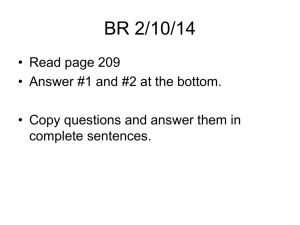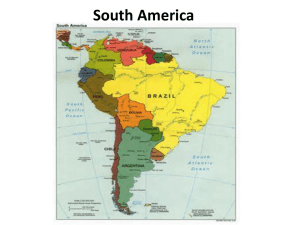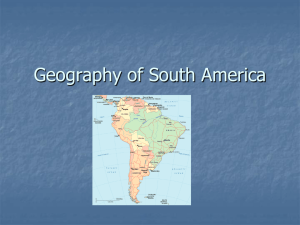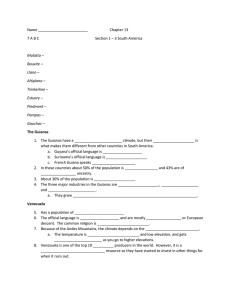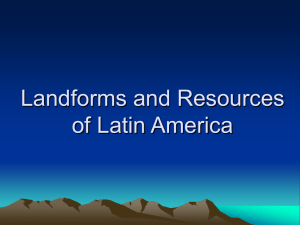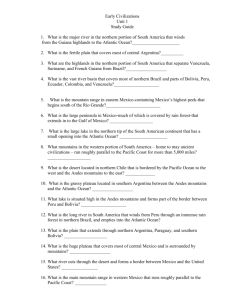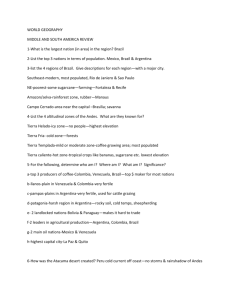SOUTH AMERICA
advertisement
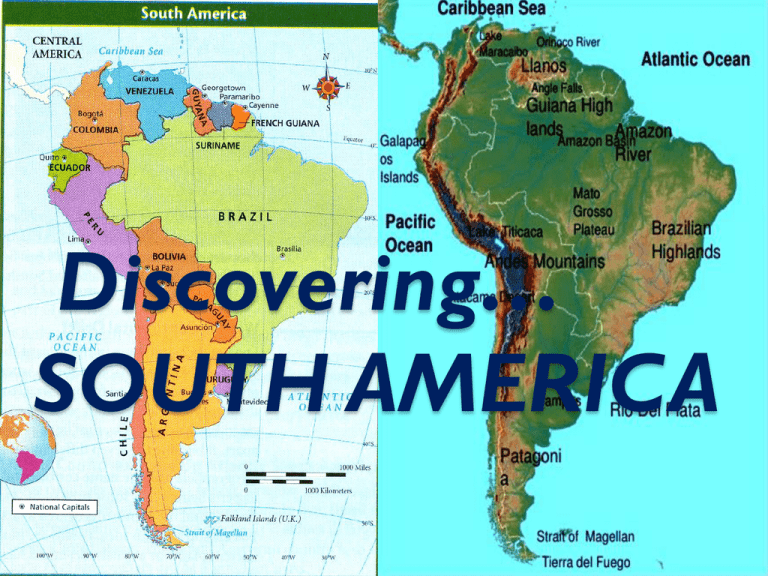
Discovering… SOUTH AMERICA German cartographer Martin Waldseemüller named the new continent after the Italian explorer, Amerigo Vespucci’s first name. is a continent located in the Western Hemisphere, mostly in the Southern Hemisphere.It can also be considered as a subcontinent of the America. It is the fourth largest continent in size and the fifth largest in population. It is located primarily in the southern hemisphere. It is bordered by the Atlantic Ocean to the east and the Pacific Ocean to the West. The geography of South America is dominated by the Andes Mountain Range and the Amazon River (second longest river in theworld). SOUTH AMERICA due to its large size, the climate varies with each region, determined by their own geographical location, ocean currents and winds. It is predominantly wet and hot. Each region having its own characteristic weather conditions. South America Climate differs from one region to another. The Amazon river basin has the typical hot wet climate suitable for the growth of rain forests. The temperatures in the Amazon basin 70 to 90 degrees F. The Andes Mountains, on the other hand, remain cold throughout the year. The temperatures of the mountains is always very low. The desert regions of Chile is the driest part of South America. The westerly winds carrying moisture shed their moisture on the western parts of the Andes, thus the eastern portions of the mountains receive very little rainfall. The cold Peru Current is responsible for the dry coastal parts of Peru as well as northern Chile. The cold current is unable to hold much moisture. The highest temperatures of South America have been recorded in Gran Chaco in Argentina, with temperaturesgoing up to 110 degrees F. The wettest place is Quibdo in Columbia. It receives an annual rainfall of 350 inches(890 centimeters). A unique feature of South America Climate is the El Nino. Every two to seven years the cold dry Peru Current weakens and warm waters from the south rush along the coast in a southward direction. The El Nion affects the Climate of South America and causes heavy rainfall in the dry parts of South America. Major Cities Buenos Aires ( Argentina) Oranjestad (Aruba) La Paz or Sucre (Bolivia) Brazil (Brasilia) Santiago (Chile) Bogota (Columbia) Quito ( Ecuador) Cayene (French Guina) Georgetown (Guyana) Asuncion (Paraguay) Lima ( Peru ) Paramibo ( Suriname ) Montevideo ( Uruguay ) Caracas ( Venezuela ) Portuguese and Spanish are the most spoken languages in South America. Spanish is the official language of most countries, along with other native languages in some countries. Portuguese is spoken in Brazil Dutch is the official language of Suriname English is the official language of Guyana and is also spoken in the Falkland Islands French is the official language of French Guiana and the second language in Amapa (Brazil) NATION CAPITAL AREA POPULATION GDP ARGENTINA Buenos Aires 2,766,890 sq km 42,192,494 $716,500,000,000 BOLIVIA La paz 1,098,580 sq km 10,290,003 $50,940,000,000 BRAZIL Brasilia 8,514,877 sq km 199,321,413 $2,294,000,000,000 CHILE Santiago 756,950 sq km 17,067,369 $299,500,000,000 COLUMBIA Bogota 1,138,910 sq km 45,239,079 $471,900,000,000 ECUADOR Quito 283,560 sq km 15,223,680 $127,400,000,000 FRENCH GUIANA Cayenne 91,351 199,509 $1,551,000,000 GUYANA Georgetown 214,999 sq km 741,908 $5,851,000,000 PARAGUAY Asuncion 406,750 sq km 6,541,591 $40,640,000,000 PERU Lima 1,285,220 sq km 29,549,517 SURINAME Paramibo 163,270 sq km 560,157 $6,326,000,000 URUGUAY Montevideo 176,220 sq km 3,316,328 $50,910,000,000 VENEZUELA Caracas 912,050 sq km 28,047,938 $374,100,000,000 $302,000,000,000 South America has a rapidly developing economy. With many industries and a flourishing trade and import-export market, it is fast becoming an economy with considerable size. South American countries had a slow pace of economic development in the past. In recent times, however, South America has as a whole undergone rapid economic development. Aided by greater economic independence since the times of the second World War, South America has been largely successful in developing its economy rapidly. The biggest individual economies in South America are those of Brazil, Argentina, Colombia and Chile. Currently undergoing massive growth are the economies of Argentina, Venezuela and Peru. Major industries in South America are agriculture, which encompasses a vital part of the economy, and other important industries like fishing, natural resources, handicrafts etc.Trade is also an important part of the economy. The manufacturing industries, agriculture, and trade primarily support the economy of South America. Some of the major agricultural products include sugarcane, corn, wheat, soybean, and coffee. South America's mineral resources also contribute substantially to the economy. Some major mineral resources found in South America are petroleum, gold, iron ore, silver, and copper. Politics in today's world enjoys a certain democratic political rule but it is gained by the continuance struggle against the decades of dictatorship and the country has passed through a lot of political crisis. Poverty and inequality were the outcome of the left influence as it was highly corrupt and inefficient at that time. Though the Politics in South America has grown economically from the past 20 years but still today the conditions not in much proper shape as it was in the 1950s. South American Politics is governed by numbers of political leaders who looks after all the aspects in the political arena. Ten years can hardly make difference in the South American Politics but this region has gained an economic growth for two years and it's a great achievement in the history of American Politics. South America culture is the combination of almost the half of the culture of this world. This continent has its own culture that was fostered by the native people who were the original part and inhabitant of this great continent. This culture had its own tradition and heritages. Later the mainstream culture was influenced by the other cultures. Among these other cultures there were the European culture, the African culture and recently the modern culture that has contribution mostly from the North America and also from other parts of the world. South American nations have a rich variety of music. Some of the most famous genres include samba from Brazil, tango from Argentina & Uruguay, and cumbia from Colombia. CHILI The Inca estate of Machu Picchu, Peru is one of the New Seven Wonders of the World The Andes are the world's longest continental mountain range. ANDES This toothy-edged, massive mountain system extends from the tip of South America all the way to Panama. It's the source of most major rivers on the continent and is 4,500 miles (7,240 km) in length. It's home to some of the planet's largest volcanoes, and in the far south along the coast of Chile, large ice sheets are commonplace. The Andes and its many ranges include dozens of peaks that reach over 20,000 ft., with the highest point being Aconcagua in Argentina, at 22,384 ft. (6,960m). The prehistoric Cueva de las Manos, or Cave of the Hands, in Argentina Plaza of San Francisco in the Historic Center of Quito in Quito, Ecuador South America is one of the largest, least-altered and best-preserved historic centers in the Americas The Amazon River is the second longest river (it is just shorter than the Nile River in Egypt) in the world and it has the largest watershed or drainage basin as well as the most tributaries of any river in the world. For reference, a watershed is defined as the area of land that releases its water into a river. This entire area is often referred to as the Amazon Basin. The Amazon River begins with streams in the Andes Mountains in Peru and flows into the Atlantic Ocean about 4,000 miles (6,437 km) away. Iguazu Falls The impressive Iguazu Falls are located between the border of Argentina and Brazil Tourism has increasingly become a significant source of income for many South American countries. Historical relics, architectural and natural wonders, a diverse range of foods and culture, vibrant and colorful cities, and stunning landscapes attract millions of tourists every year to South America. Some of the most visited places in the region are Recife, Olinda, Machu Picchu, the Amazon Rainforest, Rio de Janeiro, Salvador, Fortaleza, Maceió, Bogota, Lima, Florianópolis, Isla Margarita, Natal, Buenos Aires, São Paulo,Angel Falls, Nazca Lines, Cuzco, Lake Titicaca, Medellín, Patagonia, Cartagena and the Galápagos Islands

